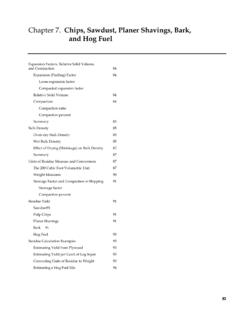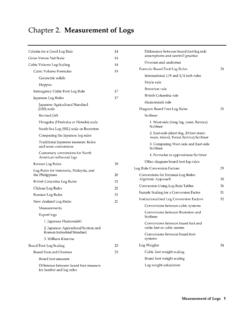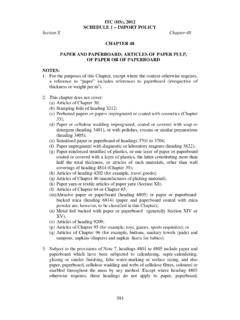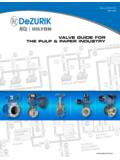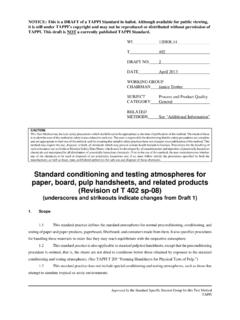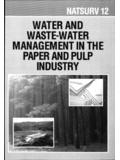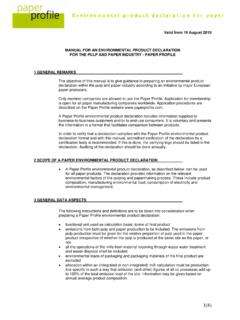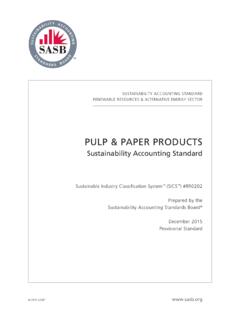Transcription of Chapter 8. Pulp and Paper
1 pulp and Paper1 pulp Yield 96 Mechanical Pulping 96 Chemical Pulping 96 Kraft (sulfate) process Sulfite process Hybrid Pulping Methods 97 Dissolving pulp 97 Estimating Wood Required per Ton of pulp 97 Paper and Paperboard 99 Basis Weight and Grammage 99 Basis weight Grammage Thickness (Caliper) 99 Density and Bulk 100 Chapter 8. pulp and Paper 2 Chapter 8 Chapter 8. pulp and Paper pulp is the fibrous mass that results when a pulping process ruptures the bonds in the wood structure that hold the woody cells together.
2 Pulping is done mechanically, thermomechanically, chemically, or with combinations of these treatments. Commercial processes are generally classified as mechanical, chemical, or semi-chemical the latter being various combinations of chemical and mechanical. Appendix 2, Section G, shows that 82% of 1986 production was chemical pulping, of which 91% is produced by the kraft (sulfate) process. Semichemical pulping accounts for about 7% of production, and various mechanical pulping processes account for the remainder. pulp statistics are usually reported in units of weight. The most common are short ton = 2,000 lb = 907 kg metric tonne = 1,000 kg = 2,204 lb.
3 pulp is generally reported as an air-dried product that is assumed to be 10% water and 90% oven-dry pulp . The actual condition of a shipment may vary somewhat from this definition. pulp is commonly sold in bales (32 x 32 x 15 inches) which weigh about 500 pounds. pulp Yield Recovery from pulping wood is commonly expressed as the percentage, by oven-dry weight, of pulp obtained from the original wood weight. A recovery value of 45% means that for every 100 oven-dry pounds of wood processed, 45 oven-dry pounds of pulp is produced. When expressed in this manner, pulp yield is mainly a function of the pulp -ing process.
4 There is some difference between hard-woods and softwoods when pulped by chemical processes, due to the difference in chemical make- up between these groups. Table 8-1 provides a summary of common pulping processes and yields. Section G of Appendix 2 shows percentage use of hardwood and softwood species. Mechanical Pulping The earliest and one of the most common mechanical pulping methods is the groundwoodprocess, in which a roundwood bolt is pressed lengthwise against a rough, revolving grinding stone. The wood fibers are torn out of the wood, abraded, and removed from the stone surface with water. A different process, called refiner mechan- icalpulp (RMP) utilizes chips, which are shredded into fibers between large rotating disks of a device called arefiner.
5 The basic RMP process has evolved to employ thermal and/or chemical presoftening of the chips, which reduces energy use and modifies resultant pulp properties; this is typically termed thermomechanical pulp (TMP). Mechanical pulping has the advantage of converting up to 95% of the dry weight of the wood input into pulp , but the mechanical action requires a large energy input. The pulp forms a highly opaque Paper with good printing properties, but the Paper is relatively weak and discolors easily with exposure to light. Newsprint is a major product of mechanical pulp . Mechanical pulps are generally produced from long-fibered softwood (conifer) species.
6 The smaller, thinner fibers from hardwoods are more severely damaged by the mechanical action, hence yield a weaker Paper . However, some hardwoods, such as poplar, which produces very bright pulp , are mechanically pulped and blended with softwood mechanical pulps to improve optical Pulping In chemical pulping, the fibers in wood are separated by dissolving away the lignin com-ponent, leaving behind a fiber that retains mostof its cellulose and some hemicellulose. Yields of chemical processes are on the order of 40 to 50% of the dry weight of the original wood input. Kraft (Sulfate) of advantagesin chemical recovery and pulp strength, the kraft process dominates the industry.
7 It represents 91% of chemical pulping and 75% of all pulp (Appendix 2, Section G). It evolved from an earlier soda process (using only sodium hydroxide as the active chem-ical) and adds sodium sulfide to the cooking chemical formulation. This is the process associated with the foul odor problem in the environment. A number of pulp grades are commonly produced, and the yield depends on the grade of product. Unbleached pulp grades, characterized pulp and Paper3by a dark brown color, are generally used for packaging products and are cooked to a higher yield and retain more of the original lignin. Bleached pulp grades are made into white papers.
8 Figure 8-1 shows a pulping curve and relationship between yield, kappa number, and corresponding product. Nearly half of the kraft production is in bleached grades, which have the lowest yields. In Figure 8-1, kappa number refers to the result of a test of the amount of residual lignin in the pulp lower kappa meaning less lignin. Effective alkali and sulfidity refer to conditions of certain key chemical aspects of the process (for details see Smook 1992). Curves such as shown in Figure 8-1 also differ with wood 8-1. Kraft pulp yield vs. kappa and effective alkali charge. Source: Smook (1992). Sulfite process uses different chemicals to attack and remove lignin.
9 Compared to kraft pulps, sulfite pulps are brighter and bleach more easily, but are weaker. Sulfite pulps are produced in several grades but bleached grades dominate production. Yields are generally in the range of 40 to 50%, but tend toward the lower end of this range in bleached grades. Compared to the kraft process, this operation has the disadvantage of being more sensitive to species characteristics. The sulfite process is usually intolerant of resinous softwoods, tannin-containing hardwoods, and any furnish containing bark. Hybrid Pulping Methods A number of processes are hybrids of chemical and mechanical methods and have intermediate yields.
10 Generally, chips are partly softened or digested with chemicals and then are mechanically converted to fiber, usually in disk refiners. Chemimechanicalpulping, typically used on hardwoods, softens chips prior to usual mechanical action and has yields in the 80 to 90% range. Semi-chemical pulping involves greater cooking and delignification prior to mechanical refining; yields are somewhat lower, depending on the degree of pulp Dissolving pulps are specialty pulps used for chemical conversion into products such as rayon, cellophane, and cellulose acetate. These pulps can be made by either a modified kraft (prehydrolysis) or sulfite process in which the aim is to obtain a pulp of pure cellulose.
